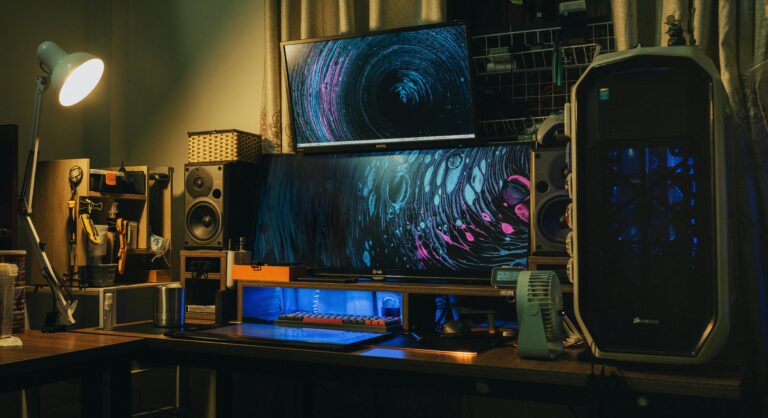The world of gaming is more than just pixels and leaderboards—it’s a deeply immersive culture that influences how we live, communicate, and even design our personal spaces. From building the perfect gaming room setup to understanding cryptic terms like GTFO meaning or what does GNG mean, every gamer becomes part of a language and lifestyle that’s constantly evolving.
This isn’t just entertainment—it’s identity. Symbols like the Berserk symbol, creatures like a Thestral, and even debates about cracked games say something about who we are in this digital universe. Whether you’re a hardcore streamer, a casual player, or a curious newcomer, understanding these facets of gaming culture helps you connect deeper with the community.
In this article, we explore how gaming influences everything from home design to internet slang, including the deeper meanings behind the icons, memes, and behaviors you see every day in chats, streams, and social media threads.
Crafting the Ultimate Gaming Room: More Than Just RGB Lights
A gamer’s setup is sacred. Your gaming room isn’t just a place to play—it’s where strategy meets self-expression. A great gaming space improves performance, immersion, and even mental health.
Here’s what goes into a modern gaming room:
- Lighting: RGB LED strips, soft ambient lamps, and monitor bias lighting enhance both mood and screen visibility.
- Sound: Noise-canceling headsets or surround sound speakers can drastically improve reaction time and immersion.
- Ergonomics: A high-quality gaming chair, adjustable desk, and monitor stands reduce fatigue during long sessions.
- Decor: Posters of favorite games, anime references, and collectibles like Funko Pops or vintage cartridges personalize the space.
Some players go further, transforming their room into full-on stream studios with green screens, boom mics, neon signs, and wall-mounted setups. The goal? Function meets fandom. A great gaming room is the physical manifestation of digital passion.
GTFO Meaning and the Rise of Online Game Slang
If you’ve ever played a multiplayer game or watched a Twitch stream, you’ve seen phrases like GTFO, GNG, or “noob” flying through the chat. Internet slang is part of the language of gaming—and sometimes, it’s more expressive than full sentences.
Let’s decode a few:
- GTFO Meaning: Short for “Get The F*** Out,” it’s a harsh but common phrase used in rage-quits, trolling, or intense PvP scenarios. It’s also the name of a notoriously difficult co-op survival horror game, “GTFO,” where getting out alive is literally the mission.
- What Does GNG Mean? In gaming, GNG typically means “Good Night Gamers” or sometimes “Gonna Go.” It’s a casual way to sign off in Discord servers or chat threads. It signals the end of a session—but keeps the tone friendly.
These acronyms and expressions build camaraderie and identity. They’re quick, punchy, and say a lot with little. Mastering gaming slang isn’t just about fitting in—it’s about speaking the culture.
Berserk Symbol: The Dark Emblem of Strength and Suffering
One of the most iconic visuals adopted by gaming and anime fans alike is the Berserk symbol, also known as the Brand of Sacrifice. Originally from the manga and anime “Berserk,” this haunting emblem represents fate, pain, and resilience in the face of overwhelming odds.
Why does it matter in gaming?
Because many players see the Berserk symbol as a badge of honor—especially in souls-like or high-difficulty games. Titles like Dark Souls, Bloodborne, and Elden Ring share themes of brutal perseverance, much like the tone of the Berserk series.
Gamers may wear the symbol in tattoos, incorporate it into custom character designs, or display it in their gaming rooms as a reminder of grit and glory. It’s more than an image—it’s a philosophy: embrace the struggle, fight until the end.
Thestral: From Wizarding Lore to Gaming Symbolism
Gamers and fantasy fans love metaphors—and the Thestral is one of the most poetic. First introduced in Harry Potter, a Thestral is a skeletal, winged horse that can only be seen by those who have witnessed death.
In gaming communities, the Thestral symbolizes:
- A deepened perspective: Understanding the cost of experience.
- Invisibility or stealth: Often used as a username or guild name for stealth-based players.
- Mystery and power: Dark, elusive, and rare—just like a skilled gamer who keeps to the shadows.
Whether used in RPG character bios or as a reference in stream overlays, the Thestral evokes depth. It’s for those who have “seen things” in-game and in life, carrying their knowledge like a quiet strength.
Cracked Games: Accessibility or Ethical Grey Zone?
One of the most debated topics in the gaming world is the use of cracked games—unauthorized copies of paid software, typically modified to bypass security protections.
Some players turn to cracked games due to:
- Financial limitations
- Regional restrictions
- Lack of access to game demos
However, there’s an ethical debate at play. While cracking can be viewed as digital rebellion or survivalism, it also affects developers, especially indie creators trying to survive in a competitive industry.
Still, cracked games remain part of gaming culture’s underground. They’re referenced in forums, Discord servers, and meme pages—not always as a crime, but as a controversial solution to the real issues of accessibility and pricing.
Streaming, Aesthetics, and Identity: More Than Gameplay
Your gaming room isn’t just for you anymore—it’s your streaming stage. Viewers tune in not just for wins and fails, but for vibes. The way you decorate, the slang you use, the overlays and lighting—these choices communicate your personality and passion.
Incorporating symbols like the Berserk symbol, referencing GTFO in stream titles, or ending your stream with a cheerful “GNG” becomes part of your brand. And yes, a plush Thestral in your background will definitely start conversations.
Streamers who lean into the language and aesthetics of gaming culture build stronger connections with their audience. It’s not just content—it’s community.
Designing a Stream-Friendly Gaming Room
With platforms like Twitch and YouTube Gaming becoming household names, your gaming room is now more than a personal sanctuary—it’s a public stage. Whether you’re a rising streamer or just getting started, setting up a stream-friendly room can drastically boost your viewer engagement.
Here’s how to blend form and function in your streaming space:
- Backdrop Aesthetics: Use subtle references like a Berserk symbol wall art, ambient lighting, or themed collectibles to spark curiosity without being distracting.
- Lighting is King: Soft lighting on your face (via a ring light or key light) and color-coordinated RGB behind you create a clean, professional look.
- Declutter Smartly: Use wall shelves or digital backgrounds to minimize distractions and highlight your personality.
- Soundproofing: Foam panels or curtains reduce echo and outside noise, making your voice clearer to your audience.
Even adding subtle personal touches like a Thestral figurine or an LED sign with “GTFO” (ironically, of course) can create a vibe that’s humorous, niche, and instantly relatable to fans of gaming lore.
What Does GNG Mean? The New Sign-Off for Streamers
As streamers create their own online lexicons, phrases like GNG (“Good Night Gamers” or “Gonna Go”) are gaining traction as signature sign-offs. More than a casual goodbye, GNG has become a lighthearted, meme-worthy way to end a stream on a fun, communal note.
Ways to use GNG in your stream branding:
- Add it as an animated emote for subscribers.
- Flash it on-screen during your ending scene.
- Create a unique sound effect or outro jingle around it.
Just like “GG” or “BRB,” GNG is part of a broader online shorthand that makes streamers more relatable and community-focused. It’s not just about playing games—it’s about speaking the same language as your viewers.
Symbolism in Gaming: More Than Aesthetic
Symbols like the Berserk symbol and mythical creatures like the Thestral aren’t just aesthetic—they carry emotional and philosophical weight. They reflect the depth and diversity of gamers who resonate with dark themes, challenging gameplay, or layered narratives.
Why these symbols matter:
- Berserk Symbol: A reminder of struggle, sacrifice, and inner strength. Often embraced by fans of punishing, soul-crushing games who see every “game over” as a lesson in perseverance.
- Thestral: A quiet nod to players who’ve experienced loss or transformation. Its visibility in fan art and usernames often indicates a deeper appreciation for narrative-driven gaming.
In the context of streaming, these references can also create thematic cohesion. Imagine a dark, medieval stream overlay with Berserk art motifs, or a subtle Thestral outline in your branding—instantly setting a mood before you even speak.
Cracked Games: The Ongoing Debate in Gaming Ethics
The issue of cracked games continues to divide the gaming community. While some defend it as a form of access and protest against expensive releases, others view it as intellectual theft.
Let’s break down both sides:
Why some gamers use cracked games:
- Unaffordable pricing in certain countries or regions.
- Lack of demo versions or trial periods for expensive titles.
- Disinterest in always-online DRM that limits offline play.
Why others avoid them:
- Ethical concerns about hurting developers, especially indie creators.
- Malware or corrupted files often hidden in pirated versions.
- Lack of support for updates, patches, and multiplayer modes.
Interestingly, the community has found a middle ground in celebrating when a previously pirated player later purchases the game after falling in love with it—turning a cracked experience into genuine support. This nuanced topic continues to spark conversations around fair pricing, game preservation, and industry evolution.
Gaming Slang and Digital Identity
Just like slang in any subculture, terms like GTFO, GNG, and others evolve into more than shorthand—they become identity markers.
Some examples of how language builds gamer identity:
- “GG” (Good Game) = Sportsmanship
- “EZ” = Cockiness (or satire)
- “GTFO” = Rage or meme-level drama
- “GNG” = Casual camaraderie and humor
- “Lag” = The universal excuse for all failures
Streamers often build their personas around these phrases. A chat full of slang-literate fans feels more cohesive, more in-tune, and more alive. And yes, learning these expressions helps new players integrate faster into competitive or social gaming environments.
Gaming Culture as a Lifestyle
Gaming isn’t just a hobby anymore—it’s a lifestyle. Between the carefully curated gaming room, Twitch personas, inside jokes, meme references, and symbolic identity markers like the Berserk symbol, players now live their passion well beyond the screen.
Even how we decorate, speak, and spend our time reflects the gaming mindset:
- Minimalism meets chaos: Clean desk setups but with RGB overload.
- Digital slang as real-world language: Telling friends “GTFO” in jest.
- Inspiration from in-game themes: Channeling fantasy, sci-fi, or cyberpunk aesthetics into clothing, art, and content.
This blend of virtual and real-world influence is exactly what makes modern gaming culture so immersive—and so unique.
Conclusion: Gaming Culture Is Deep, Symbolic, and Ever-Evolving
From the way we build our gaming rooms to how we sign off with a simple GNG, the language and symbolism of gaming culture shape how we connect with each other. Whether you’re using the Berserk symbol as your digital crest, referencing Thestrals in your usernames, or joking about cracked games in chat, you’re part of a massive, ever-growing subculture.
Gaming is no longer just about play—it’s about expression, community, and identity.
So next time you hear “GTFO” in a lobby, know it’s more than an insult—it’s part of the theater. When you say “GNG” at the end of a long stream, you’re not just logging off—you’re signing off with style.
This is the language we speak. This is the world we build. One game, one stream, one phrase at a time.















